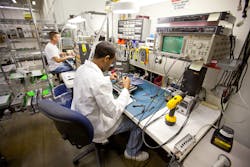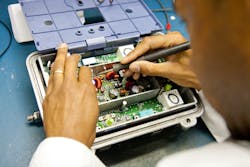Uncertainty has been a characteristic of supply chain management ever since business became international. But in recent years, the complexity of global trade, compounded by the COVID-19 crisis, has directed major companies to become more strongly focused on supply chain risk.
“Semiconductors and electronics are historically a cyclical business, so we usually see a market cycle ebb and flow about every four years,” said Peggy Carrieres, vice president of Sales Enablement and Supplier Development, Avnet, a global technology distributor based in Phoenix, Ariz. that employs more than 2,000 engineers in 48 countries.
Before the pandemic, Avnet forecasted an 8% uptick in revenue in 2020, said Carrieres. But a number of macroeconomic factors would shift the balance. “In September 2020, due to trade issues between the U.S. and China, we saw some changes for manufacturers,” she explained. “We had global output issues because of the pandemic, we had logistics challenges, there were natural disasters, fab fires, earthquakes…All of this happened over the past two years.”
Geopolitical market challenges have become the norm. “Where a customer chooses to build will impact the supply chain,” said Carrieres, adding that Avnet’s advantage of being a broadline distributor means that it has a reach that spans across the globe. “We can pivot and stay agile to meet the changing needs of the market and in the macroeconomic state.”
On March 1, Avnet made public the results of an inaugural survey, Avnet Insights, which focused on trends impacting design engineers in the electronics industry. Among the key takeaways, it showed that due to chip shortages, access to electronic components has been a very significant challenge.
Carrieres pointed out that shortages are changing the way engineers design. According to the survey, availability is impacting more than just where engineers are seeking the parts for their designs. It is impacting how they create designs, she said. Two-thirds (64%) of survey respondents said their company is designing more based on availability of components over preference.
“The shift from designing based on first choice to designing based on first available for a prolonged period is a ripple effect from the overall shortages that could significantly impact the electronics industry,” said Carrieres. “However, it also represents an opportunity for engineers to lean on their partners with added visibility into the supply chain to ensure they are creating flexibility in their designs based on market conditions to avoid compromising quality.”
Respondents who experienced a significant impact due to the shortages (93%) cited lead times as having a direct effect. This impact was followed by delayed production schedules (74%) and higher prices (72%). A strong majority of respondents (96%) expressed concerns about lead times getting longer and about price increases over the coming year.
In addition, the survey found that design engineers are seeking additional routes to source parts, including through spot market brokers. “Current conditions call for having dual sources, where you can make sure that you have supplier A and B that are qualified, so that if one is a stock out, you can pivot to the other,” advised Carrieres.
These considerations are important in designing flexibility into the next generation of components, she explained, as designers might consider the cost of swapping out a piece from a module and change 20%, as opposed to redesigning the whole unit.
According to the survey results, when design-in components are not available, most respondents rely on redesigned boards (55%), pin-to-pin replacements with better specs (53%) or drop-in replacements (49%). These preferences vary regionally, noted Avnet. For instance, designers in the Americas are most likely to use drop-in replacements, with nearly three-in-four (73%) reporting they have done so.
“Some ICs, such as a microcontroller or FPGA, are really hard to retrofit for another supplier,” said Carrieres. “But having a dual design up front—option A and option B—means you can take that into production and have some flexibility.”
The survey also found that respondents had significant concerns about counterfeit control, which could compound design and quality issues over the long-term, noted Avnet.
About the Survey
The Avnet Insights customer survey was conducted among n=530 global engineers. Regionally, 31% of respondents were based in the Americas; 56% in EMEA; 10% in Asia and 2% in Japan. The survey was fielded online from Nov. 4 to Dec. 3, 2021 using Avnet’s global customer database.



